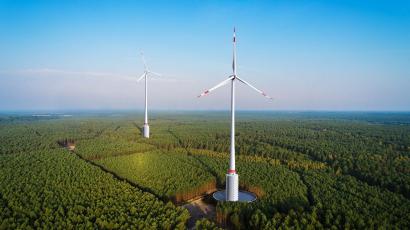Wind turbines are designed to generate energy, not store it. When winds are sufficient, the power goes straight to the transmission grid. But if the grid gets more energy than it can handle, electricity prices drop and turbines are shut down. The reverse is also an issue. When winds are low, turbines earn little to nothing.
Energy storage systems are one answer to the variability challenge of wind-generated power. However, most battery-based systems are still too costly to combine with most wind farms. So engineers in Europe have been busy thinking outside the box and inside the turbine tower.
Their idea is to have towers on top of tall bases that serve as power-storage devices, holding water for hydroelectric generation. When power is in surplus, water is pumped into the upper reservoir. When winds slow or stop, the water is discharged through a hydro-turbine.
Multi-national construction company, Max Bögl, has taken the lead of this idea and fully built a four-turbine pilot project with integrated hydropower that’s currently running successfully. It is the first of its kind, located in Germany’s Swabian-Franconian Forest in the town of Gaildorf.
“The water battery is a natural storage facility which stands out for its durability and high degree of flexibility,” says Jürgen Joos, CFO at Max Bögl Wind AG.
According to GE Renewable Energy, which supplied the turbines for the project: “The project creates an affordable way to store excess energy in a natural reservoir, and integrates the source and storage into one system.”
But there is a catch. For the system to work, location is key. Turbines must sit atop a hill with a fall height of at least 490 ft and with a water resource in a radius of about three miles for the first fulfillment of the storage system. For the pilot project, a man-made lake is situated 600 ft below the wind farm. The plant itself will work much like a hydro-pump station. Water flowing downhill from the reservoirs will supply additional power to the hydro plant when electricity is needed. Conversely, when the energy supply is high, the hydro plant can pump water back uphill to the reservoirs.
In this manner, the system acts like a giant battery. Wind and water work together to ensure efficient electrical output from the plant. The wind project features GE’s 3.4-MW turbines with 440-ft diameter rotors. The 131-ft tall base doubles as a water reservoir and can hold up to 1.6 million gallons. It further adds to the tower height, so the rotors will sweep up to 807 ft.
The wind turbines sit in reservoirs that can hold nine million gallons of water. At full capacity, the wind farm should produce 13.6 MW, along with another 16 MW from the hydroelectric capability.
Along with the wind turbines, GE is supplying the management software, which is intended to make the plant run more efficiently. The company’s Digital Wind Farm suite can collect and analyze data from different sources, such as the turbines and grid, to maximize power production. If all goes well, Max Bögl says it expects to build one or two similar projects a year in Germany after 2019.
Share your industry press now!
Are you a PR agency or sustainability-focused organization? Join the World of Renewables network FREE today and gain exclusive access to our platform to promote your business, share the latest industry news, and connect with a global audience of 700,000+ renewable energy professionals.
Register Now to start posting your updates and showcase your expertise to a highly engaged, environmentally-conscious community.
Find out more about our Content Partnership Programs.*2024 AWARD WINNER* Websites & Mobile Sites, Webby Winner, Peoples Voice 2024














